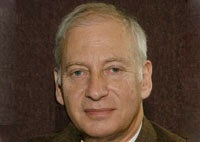Breaking the Most Toxic Addiction of All

Posted in GUMC Stories
 It’s a New Year, and time to get serious about the resolutions — great and small — that people often make at this time to correct a behavior. But when it comes to stopping smoking, many just can’t get past the utterance of “I resolve…” Studies have shown that 70 percent of smokers want to stop, and 44 percent of them try each year. Only between 4-7 percent are successful.
It’s a New Year, and time to get serious about the resolutions — great and small — that people often make at this time to correct a behavior. But when it comes to stopping smoking, many just can’t get past the utterance of “I resolve…” Studies have shown that 70 percent of smokers want to stop, and 44 percent of them try each year. Only between 4-7 percent are successful.
Many at Georgetown University Medical Center may experience such a dilemma, as GUMC goes smoke free in 2012.
George Kolodner, M.D., sympathizes. He knows how hard it can be — not because he has the habit, but because he is an expert in addiction. A clinical professor of psychiatry at Georgetown University Medical Center, Kolodner teaches all levels of medical school students as well as residents and psychiatric fellows about addiction to alcohol, drugs, and tobacco and treatment.
And, as medical director of the Kolmac Clinic, an outpatient treatment facility for substance use disorders, which has six campuses in D.C. and Maryland, Kolodner practices what he preaches. In the 1970s, he designed the Kolmac Clinic program of integrated outpatient detoxification, rehabilitation, and continuing care, which was the first of its kind in the nation. His inspiration came from the time he served as a staff psychiatrist at the U.S. Naval Hospital in Bethesda, witnessing recovery from alcoholism at the hospital’s residential rehabilitation program. He thought the same kind of help with addictions could be provided on an outpatient basis. “Many people prefer to remain on their jobs and with their families during treatment,” he says.
Over the decades, the program has helped thousands of patients addicted to drugs (prescription or street) and/or alcohol. But it did not tackle tobacco addiction until last year.
That’s because dogma in the rehabilitation community dictates that it is too difficult, if not dangerous, to handle all addictions at once, Kolodner says. But he doesn’t believe it. And he says that cigarette use is much more lethal than abuse of alcohol or drugs combined. Drugs kill about 10,000 people a year in the U.S. Alcohol claims 100,000 users each year. But tobacco is responsible for 440,000 deaths annually, Kolodner says.
And tobacco use is especially common among addicts.
Up to 70 percent of the two thousand patients admitted each year to Kolmac are addicted to tobacco in addition to other substances. “While use of cigarettes has declined in the country as a whole, that is not true among people with substance disorders,” he says. “And for addicts, smoking is much harder to quit because nicotine is so addictive. It goes straight to the brain.”
For those reasons, Kolodner has borrowed, tweaked, and implemented a treatment program for tobacco addiction from the Mayo Clinic. His pilot project was launched last March, and so far, 20 percent of patients at Kolmac Clinic have decided to try this approach, and half of them have succeeded, he says.
The way to prevent addicts from smoking, he says, is to provide enough nicotine through FDA-approved mechanisms to satisfy cravings. Those methods include use of the agent Chantix, the anti-depressant Wellbutrin, nicotine patches, gum, and/or lozenges, and a low dose nicotine inhaler. The difference between this method and most quit-tobacco programs is the amount of nicotine used, he says. “Most traditional programs recommend a low dose of nicotine used for a short time. It rarely works.
“Giving nicotine addicts the nicotine they want is much safer and healthier than having them smoke cigarettes, which is why this method is called harm reduction,” Kolodner says. “It is the smoking of tobacco that produces most of the unhealthy toxicity.”
After addicts at the Kolmac Clinic have established a stable recovery from their tobacco dependence, they can then slowly reduce their use of nicotine, Kolodner says.
He says that, “there are no models for doing this in an addiction treatment center.” And Kolodner says it will be a long slog to change the minds of addiction counselors, because many of them are recovering addicts who have never given up cigarette smoking. “Tobacco has always had a curious spot in the addiction treatment world, because so many people hang on to the habit.
“But I tell our patients that they can stop smoking, even as they give up other addictions, and that this will enhance their overall recovery,” says Kolodner. “And I would tell smokers at GUMC that an aggressive approach will work for them. It is not easy, but it is easier than they might think.”
By Renee Twombly, GUMC Communications
